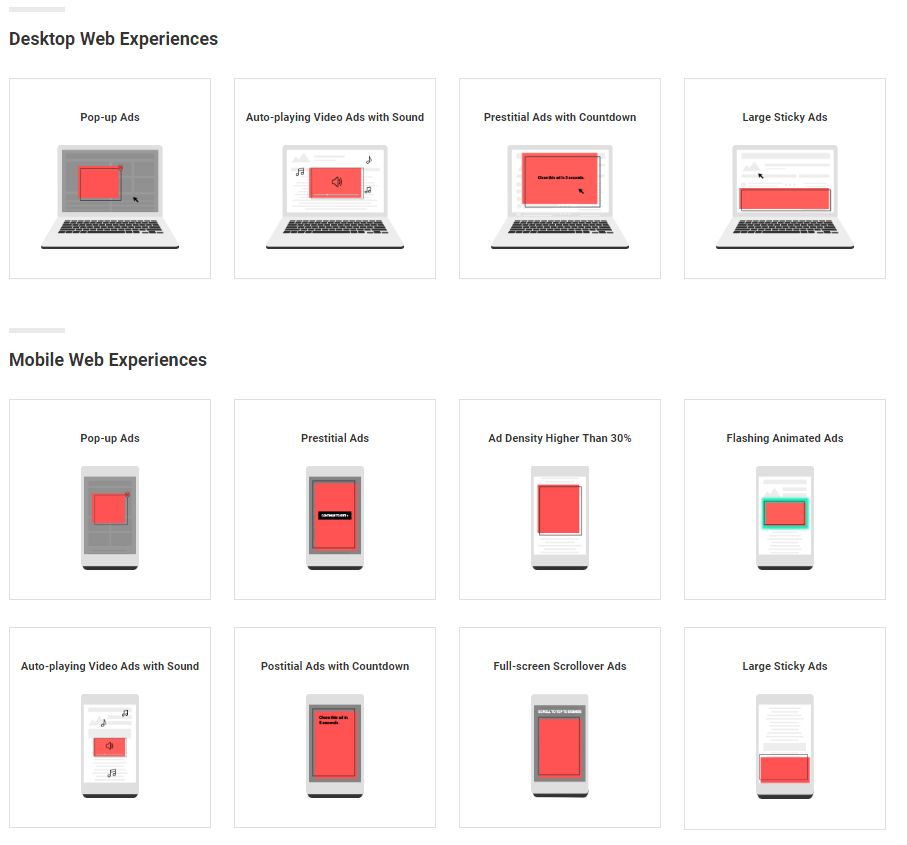The new adblock of Google Chrome
Reading time: 4 minutesToday Google implements its adblocker on Chrome!
In April 2017, Google announced its desire to implement a default ad blocker on Google Chrome in North America and Europe. Today it is taking action!
Too much advertising, undermine advertising.
Let’s go back a few steps and look at the reasons why users add an adblock to their browser. Online content creators want to make their website attractive. That’s why they provide interesting advertisements for their target audiences. But in a lot of cases, the websites are invaded by ads, which can get annoying and intrusive in the customers’ path and push them to install Adblocks. 69% of people using Adblock on their browser were motivated by too many ads! These Adblocks block all kind of advertising, such as irritating advertisements, but they also penalise advertisers!
Thus, in order to improve the user experience and help advertisers, Google has decided to block advertisements that may encourage users to install ad blockers.
Coalition for Better Ads – Advertising norms based on consumer preferences
During the year 2017, Google joined the Coalition for Better Ads in its study on improving consumers’ online advertising experience. The objective of the study is to develop norms based on consumer preferences in relation to the types of advertising they prefer the least. After conducting a survey of 25,000 consumers, the Coalition for Better Ads compiled a list from the most attractive to the most boring ads. 12 advertising formats emerged as potentially disturbing or misleading to visitors. The following ads were thus regarded as having a negative influence on users:

Desktop
- Pop-up ads
- Auto-play video ads with sound
- Prestitial ads with countdown
- Large sticky ads.
Mobile
- Pop-up ads, prestitial ads
- Ads with density greater than 30%
- Flashing animated ads
- Auto-play video ads with sound
- Poststitial ads with countdown
- Full-screen scrollover ads
- Large sticky ads
Chrome Browser will scan each website and stop displaying ads on sites that do not conform to Coalition for Better Ads norms. As long as your ads are not in this list, your chances of being affected to your advantage are very high.
Google Chrome – who’s next?
There’s not only Google who cares about online advertising. Apple’s browser, Safari, also wants to give the user a better user experience. Not through a new adblocker, but by protecting the personal data of internet users. How? By blocking ad tracking.
Different means but the same goal: Limit the usage of adblockers to protect advertisers and facilitate the user experience.
How does this affect advertisers?
In 2017 58.3% of users worldwide were using Chrome as their standard browser. Most advertisers rely on Google Adwords to conduct their advertising campaigns. If you are familiar with Google Adwords, creating a qualitative ad is (or should be) already a natural move for you, since spammy ads do not help you rank high in the search results.
The implemented ad blocker is going to impact advertisers for the better, since the environment will be less cluttered and will help qualitative ads. Since advertisers strive to create ads that perform and that give a good ROI, they know that it is not always easy to rank on a low budget – especially in higly competitive niches. However, this implemented adblocker can play to advertisers’ advantage, since irrelevant ads will be penalised. Ads will be centred on consumers’ needs and interests, rather than on randomly advertised products. It is therefore vital that you know your target audience (nothing new, right?).
Shifting to other channels
The implemented adblocker could lead to a shift to social media, which would mean that influencer marketing becomes even more important to reach your target audience and to advertise your products or services. Just make sure that the influencers you find are genuine.
Another channel to be focussing on is video advertising. Video ads have been becoming more and more popular over the last years. It is a great opportunity to make your product stand out from the crowd and address your audience directly in a non-invasive way. However, if your audience uses mostly other browsers, this new Google feature won’t be affecting your ads. Which means that you are safe, for now.
Need more advices?
Do you have any questions or problems with this new default ad blocker? Do not hesitate to contact us. We are here to help you!
Awesome post. Thank your for sharing such a nice article.
http://www.leadlake.com